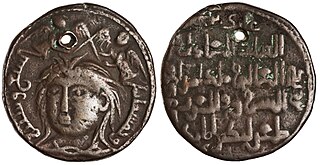
Salah ad-Din Yusuf ibn Ayyub, commonly known as Saladin, was the founder of the Ayyubid dynasty. Hailing from a Kurdish family, he was the first sultan of both Egypt and Syria. An important figure of the Third Crusade, he spearheaded the Muslim military effort against the Crusader states in the Levant. At the height of his power, the Ayyubid realm spanned Egypt, Syria, Upper Mesopotamia, the Hejaz, Yemen, and Nubia.

The Zengid or Zangid dynasty was an Atabegate of the Seljuk Empire created in 1127. It formed a Turkoman dynasty of Sunni Muslim faith, which ruled parts of the Levant and Upper Mesopotamia, and eventually seized control of Egypt in 1169. In 1174 the Zengid state extended from Tripoli to Hamadan and from Yemen to Sivas. Imad ad-Din Zengi was the first ruler of the dynasty.

Imad al-Din Zengi, also romanized as Zangi, Zengui, Zenki, and Zanki, was a Turkoman atabeg of the Seljuk Empire, who ruled Mosul, Aleppo, Hama, and, later, Edessa. He was the namesake and founder of the Zengid dynasty of atabegs.

Nūr al-Dīn Maḥmūd Zengī, commonly known as Nur ad-Din, was a member of the Zengid dynasty, who ruled the Syrian province of the Seljuk Empire. He reigned from 1146 to 1174. He is regarded as an important figure of the Second Crusade.

Kilij Arslan II or ʿIzz ad-Dīn Kilij Arslān ibn Masʿūd was a Seljuk Sultan of Rûm from 1156 until his death in 1192.
Majd ad-Dīn Usāma ibn Murshid ibn ʿAlī ibn Munqidh al-Kināni al-Kalbī or Ibn Munqidh was a medieval Arab Muslim poet, author, faris (knight), and diplomat from the Banu Munqidh dynasty of Shaizar in northern Syria. His life coincided with the rise of several medieval Muslim dynasties, the arrival of the First Crusade, and the establishment of the crusader states.

Mughith al-Dunya wa'l-Din Mahmud bin Muhammad known as Mahmud II was the Seljuk sultan of Iraq from 1118–1131 following the death of his father Muhammad I Tapar. At the time Mahmud was fourteen, and ruled over Iraq and Persia.

The Artuqid dynasty was established in 1102 as a Beylik (Principality) of the Seljuk Empire. It formed a Turkoman dynasty rooted in the Oghuz Döğer tribe, and followed the Sunni Muslim faith. It ruled in eastern Anatolia, Northern Syria and Northern Iraq in the eleventh through thirteenth centuries. The Artuqid dynasty took its name from its founder, Artuk Bey, who was of the Döger branch of the Oghuz Turks and ruled one of the Turkmen beyliks of the Seljuk Empire. Artuk's sons and descendants ruled the three branches in the region: Sökmen's descendants ruled the region around Hasankeyf between 1102 and 1231; Ilghazi's branch ruled from Mardin and Mayyafariqin between 1106 and 1186 and Aleppo from 1117–1128; and the Harput line starting in 1112 under the Sökmen branch, and was independent between 1185 and 1233.

The siege of Edessa took place from 28 November to 24 December 1144, resulting in the fall of the capital of the County of Edessa to Zengi, the atabeg of Mosul and Aleppo. This event was the catalyst for the Second Crusade.
Yarankash was a Frankish slave who assassinated his owner Zengi, the atabeg of Aleppo. According to Damascene chronicler Ibn al-Qalanisi:
Mu'in ad-Din Unur al-Atabeki was a mid-12th century ruler of Damascus from 1140 to 1149. He was a Turkoman slave of Burid emirs.

Qutb al-Din Mawdud was the Zengid Emir of Mosul from 1149 to 1169. He was the son of Imad al-Din Zengi and brother and successor of Sayf al-Din Ghazi I.
Mujīr ad-Dīn ʿAbd al-Dawla Abu Saʿīd Ābaq ibn Jamāl ad-Dīn Muhammad was the Burid emir of Damascus from 1140 to 1154. He was the eldest son of Jamal ad-Din Muhammad and the last Burid ruler of the Emirate of Damascus.
The military history of the Crusader states begins with the formation of the County of Edessa in 1097 and ends with the loss of Ruad in 1302, the last Christian stronghold in the Holy Land.

Sayf al-Din Ghazi (II) ibn Mawdud was a Zangid Emir of Mosul, the nephew of Nur ad-Din Zengi.
Alp Arslan ibn Mahmud was ruler of Mosul from 1127-1146. As son of Mahmud II, he was appointed governor of Mosul in 1127 with Zengi as his atabeg. While governor in name only, Alp aspired to replace Ghiyath ad-Din Mas’ud as sultan upon his death. In 1145, Alp conspired to kill Zengi’s deputy Naşīr al-Dīn Jaqar and take control of Mosul. His co-conspirator was likely Farrukh-Shāh ibn Mahmūd, who provided assurances that the army would support Alp. Naşīr was killed by Alp, Farrukh or their followers, and his head thrown for effect towards Zengi’s forces. Qadi Taj al-Din Yahya ibn Shahrazuri encouraged Alp to take control of the citadel at Mosul, escorting him there, where he and his followers were arrested by Zengi loyalists. Zengi dispatched his commander Zain-ad-Din ‘Ali Küchük to control the situation. The conspirators were executed and Alp was kept close to Zengi until his death in 1146. Alp Arslan was then replaced by Zengi’s son Saif ad-Din Ghazi I who had him imprisoned.

Husam al-Din Timurtash was an Artuqid emir of Mardin (1122–1154) and ruler of Aleppo (1124–1125).

Abul Fatah Imad ad-Din al-Malik al-Adil Zengi Ibn Moudud, better known as Imad ad-Din Zengi II, was an emir of the Sinjar-based Zengid dynasty and the first son of Qutb al-Din Mawdud. He ruled from 1171 to 1197 Sinjar and 1181–83 Aleppo.











